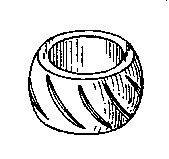BEAD CRIMPING PLIERS TIPS & NOTES
"French" Crimps
 "French" crimps require special care when crimping. Because they are shaped like a tiny barrel, it is more difficult to keep them properly aligned in the crimping station. One way to ease this difficulty is to first use the rounding section to gently shape the crimp to an oval. This initial forming step will smooth the walls and reshape the crimp to be more like an oval tube than a barrel.
"French" crimps require special care when crimping. Because they are shaped like a tiny barrel, it is more difficult to keep them properly aligned in the crimping station. One way to ease this difficulty is to first use the rounding section to gently shape the crimp to an oval. This initial forming step will smooth the walls and reshape the crimp to be more like an oval tube than a barrel.
It's not a bad idea to reshape all your "French" crimps this way before even using them in a piece. The offset jaws allows you to reshape the crimps with one hand while they lie flat on your work bench. The advantage of reshaping this type of crimp is that you can easily see which ones are going to give you trouble and discard them.
Reforming or Replacing Flat Crimps
Before you rip up that piece with the ugly flat crimps you may want to try this tip. Using the rounding station, much like the second "rounding" step, grip the flattend crimp across its ends and slowly apply pressure. The flat crimp will begin to open and when it reaches the shape of an oval you can then re-crimp or replace it.
Don't Throw Out Those Chain Nose Pliers Yet
One advantage of a flattened crimp (perhaps the only one) is that it can be opened up in order to shorten or slightly modify a piece. Indeed, one of the complaints of the Bead Crimper is that the crimp cannot be opened at all. So if you want to temporarily secure the piece and finish up the crimps later, don't throw out those chain nose pliers yet.
Stretch Control
One of the benefits of knotting is that as the piece stretches, no large gap develops. Actually the stretch still develops but the single gap that normally would occur is now a bunch of tiny gaps distributed between all the knots.
When stringing on wire, crimps may be used in place of knotting. It is not necessary to use a lot of crimps to control the stretch. For example, suppose you uniformly spread out only 7 crimps over a heavy necklace. If the necklace now stretched 1/2 inch over time then each of the 8 segments would only show a 1/16 inch gap. Note: the beads should not slip over the crimps for this method to work.
Why Flattened Crimps Loosen
When you simply flatten a crimp bead there will almost always be some air space left inside the crimp for the wire to wiggle into. In order to achieve the most secure crimp, you need to completely wrap up the wires and leave no space whatever. This is the reason for the dimple found in most electrical connector crimping tools. Although you could build a small version of an electrical connector crimping tool, it would only work for one size of crimp and one size of wire.
The two step crimp forming process used by the Bead Crimping Pliers eliminated the need for having a different crimping die for different crimp and wire sizes. Here by further rolling up the kidney shaped crimp formed in the first step, you can accommodate a wide range of different wire and crimp sizes and still eliminate the empty space.
How to Recognize the "Rip-off" Crimpers
First, if the color of the handles is anything but black or blue, e.g. red, pink,turquoise,..., then you have a rip-off. As you might suspect the "rip-offs" are very poor quality with a flimsy bearing and poorly formed crimping dies.
After 1995 there have been four authorized production models - two having ribbed black handles and one having ribbed blue handles. The two black handle models are the standard model and the micro crimper. The standard model was produced through 2002 and the micro crimper was introduced in 2002. For both of these black handle models one of the arms is stamped with "US patents" and two of the three patent numbers: "D356,520" and "5,426,843". Another valid model of recent release is a standard crimper with blue handles, stamped with three patent numbers: "D356,520", "5,426,843", and "DES 366,199". The second arm for both the blue and black handle models is stamped with the country of origin, "TAIWAN", and "USE SAFETY GLASSES". The latest production will have only a stamping of patent number 5,426,843 as the other two patents have expired.
You might also have one of two types of earlier standard models made between December 1991 and June 1995 before the patents issued. The earliest type made from 1991 through early 1995 had smooth black handles and was stamped "USE SAFETY GLASSES" and "MADE IN U.S.A." The other earlier type made only in 1995 had black ribbed handles but nothing stamped on either of the arms. The instructions for both of these early tools indicated patents were pending.
If you know of any company or individual selling an unauthorized copy of the Bead Crimping Pliers please e-mail us. It would be greatly appreciated.
If you have any questions concerning the tool or any tips on its use, we would like to hear from you. You may reach us at (312) 263-3313 or you may send an e-mail.
Home
Instructions
Crimping Animation
Protected by U.S. Patent Nos. 5,426,843 and copyrights 1991/present. All Rights Reserved.